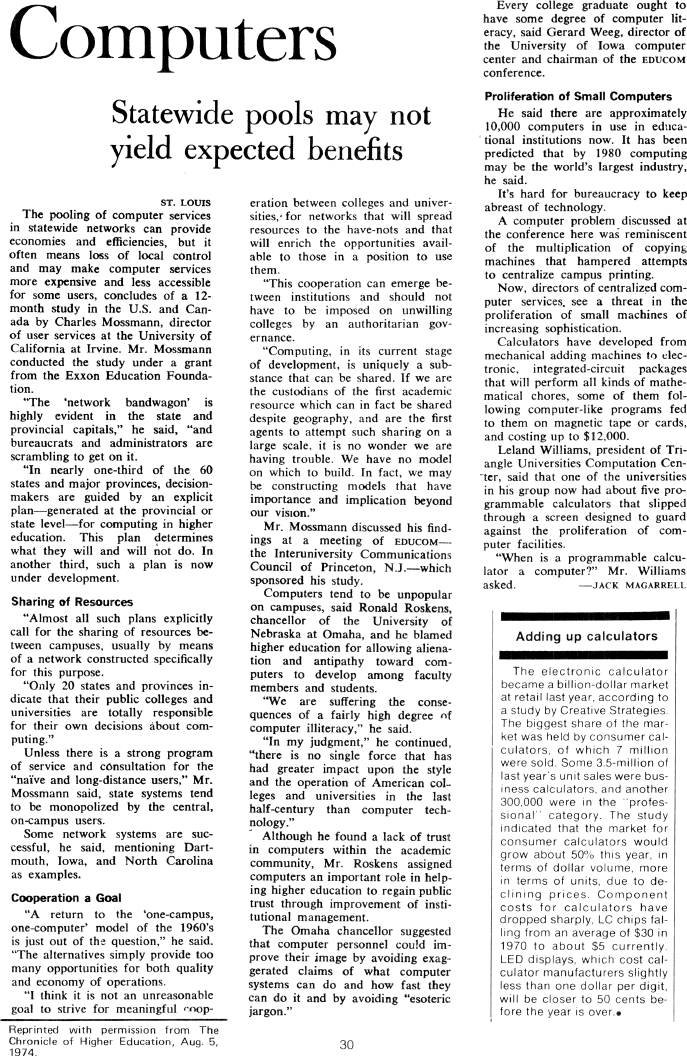The Best of Creative Computing Volume 1 (published 1976)
Statewide Pools May Not Yield Expected Results (Pooling of computer services in statewide networks)

Computers
Statewide pools may not
yield expected benefits
ST. LOUIS
The pooling of computer services
in statewide networks can provide
economies and efficiencies, but it
often means loss of local control
and may make computer services
more expensive and less accessible
for some users, concludes of a 12-month study in the U.S. and Canada by Charles
Mossmann, director
of user services at the University of
California at Irvine. Mr. Mossmann
conducted the study under a grant
from the Exxon Education Foundation.
"The ‘network bandwagon' is
highly evident in the and
provincial capitals,” he said, "and
bureaucrats and administrators are
scrambling to get on it.
'In nearly one-third of the 60
states and major provinces, decision-makers are guided by an explicit
plan-generated at the provincial or
state level-for computing in higher
education. This plan determines
what they will and will not do. ln
another third, such a plan is now
under development.
***
Sharing of Resources
"Almost all such plans explicitly
call for the sharing of resources between campuses, usually by means
of a network constructed specifically
for this purpose.
"Only 20 states and provinces indicate that their public colleges and
universities are totally responsible
for their own decisions about computing."
Unless there is a strong program
of service and consultation for the
'naive and long-distance users," Mr.
Mossmann said, state systems tend
to be monopolized by the central,
on-campus users.
Some network systems are successful, he said, mentioning Dartmouth, Iowa, and
North Carolina
as examples.
***
Cooperation a Goal
"A return to the ‘one-campus,
one-computer' model of the 1960's
is just out of the question,” he said.
"The alternatives simply provide too
many opportunities for both quality
and economy of operations.
"I think it is not an unreasonable
goal to strive for meaningful cooperation
Reprinted with permission from The
Chronicle of Higher Education, Aug. 5,
1974.
between colleges and universities,'for networks that will spread
resources to the have-nots and that
will enrich the opportunities available to those in a position to use
them.
"This cooperation can emerge between institutions and should not
have to be imposed on unwilling
colleges by an authoritarian governance.
"Computing, in its current stage
of development, is uniquely a substance that can be shared. If we are
the custodians of the first academic
resource which can in fact be shared
despite geography, and are the first
agents to attempt such sharing on a
large scale, it is no wonder we are
having trouble. We have no model
on which to build. In fact, we may
be constructing models that have
importance and implication beyond
our vision.”
Mr. Mossmann discussed his findings at a meeting of EDUCOM- the lnteruniversity
Communications
Council of Princeton, N.J.-which
sponsored his study.
Computers tend to be unpopular
on campuses, said Ronald Roskens,
chancellor of the University of
Nebraska at Omaha, and he blamed
higher education for allowing alienation and antipathy toward computers to
develop among faculty
members and students.
"We are suffering the consequences of a fairly high degree of computer
illiteracy," he said.
"In my judgment,” he continued,
"there is no single force that has
had greater impact upon the style
and the operation of American colleges and universities in the last
half-century than computer technology."
Although he found a lack of trust
in computers within the academic
community, Mr. Roskens assigned
computers an important role in helping higher education to regain public
tmst through improvement of institutional management.
The Omaha chancellor suggested
that computer personnel could improve their image by avoiding exaggerated claims
of what computer
systems can do and how fast they
can do it and by avoiding "esoteric
jargon.”
30
Every college graduate ought to
have some degree of computer literacy, said Gerard Weeg, director of
the University of Iowa computer
center and chairman of the EDUCOM
conference.
***
Proliferation of Small Computers
He said there are approximately
l0,000 computers in use in educational institutions now. It has been
predicted that by l980 computing
may be the world's largest industry,
he said.
It's hard for bureaucracy to keep
abreast of technology.
A computer problem discussed at
the conference here was reminiscent
of the multiplication of copying
machines that hampered attempts
to centralize campus printing.
Now, directors of centralized computer services, see a threat in the
proliferation of small machines of
increasing sophistication.
Calculators have developed from
mechanical adding machines to electronic, integrated-circuit packages
that will perform all kinds of mathematical chores, some of them following
computer-like programs fed
to them on magnetic tape or cards,
and costing up to $12,000.
Leland Williams, president of Triangle Universities Computation Cen'ter, said
that one of the universities
in his group now had about five programmable calculators that slipped
through a screen designed to guard
against the proliferation of computer facilities.
"When is a programmable calculator a computer?" Mr. Williams
asked. -JACK MAGARRELL
***
Adding up calculators
The electronic calculator
became a billion-dollar market
at retail last year, according to
a study by Creative Strategies.
The biggest share ol the market was held by consumer calculators, of which 7
million
were sold. Some 3.5-million of
last year's unit sales were business calculators. and another
300,000 were in the "professional" category. The study
indicated that the market for
consumer calculators would
grow about 50% this year, in
terms of dollar volume, more
in terms of units, due to declining prices. Component
costs for calculators have
dropped sharply, LC chips falling from an average of $30 in
1970 to about $5 currently
LED displays, which cost calculator manufacturers slightly
less than one dollar per digit,
will be closer to 50 cents before the year is over..


